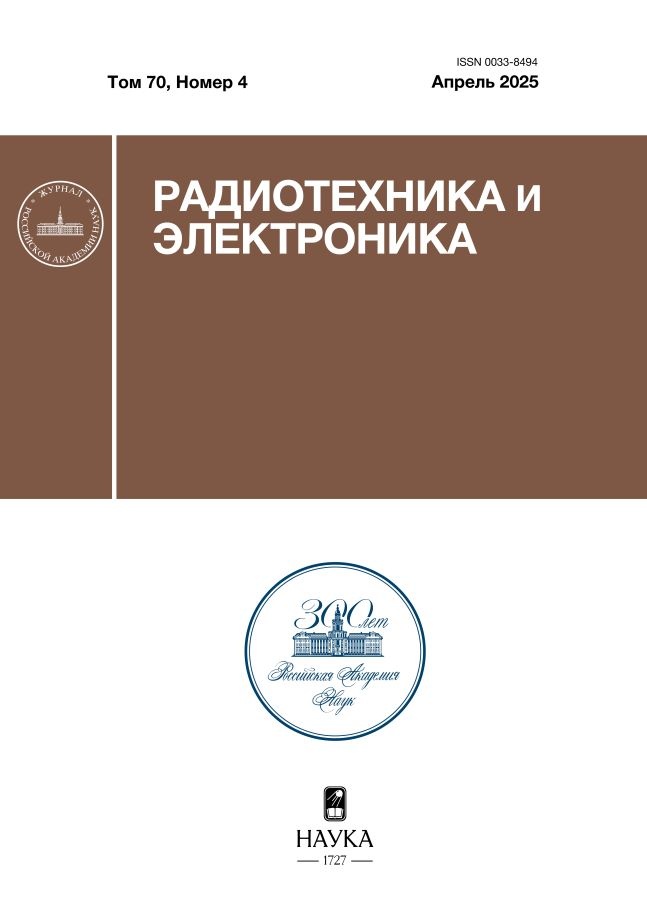Double negative media based on magnetic metamaterials and semiconductors for the microwave frequency range
- 作者: Grishin S.V.1, Amel’chenko M.D.1, Zhabova A.V.1, Ogrin F.Y.2,3, Nikitov S.A.4
-
隶属关系:
- Saratov State University, named after N.G. Chernyshevsky
- University of Exeter
- MaxLLG Ltd.
- Kotelnikov Institute of Radioengineering and Electronics of RAS
- 期: 卷 70, 编号 4 (2025)
- 页面: 396-404
- 栏目: TO THE 70th ANNIVERSARY OF S.A. NIKITOV
- URL: https://archivog.com/0033-8494/article/view/687513
- DOI: https://doi.org/10.31857/S0033849425040094
- EDN: https://elibrary.ru/FRYYQE
- ID: 687513
如何引用文章
详细
The results of theoretical study and MaxLLG program simulation of the ferromagnetic metamaterials with metallic (non-magnetic) inclusions, as well as the bigyrotropic media with the properties of a ferromagnetic semiconductor are presented. The possibility of obtaining the double negative media from such materials in that a backward electromagnetic wave exists at microwave frequencies is demonstrated.
全文:
作者简介
S. Grishin
Saratov State University, named after N.G. Chernyshevsky
编辑信件的主要联系方式.
Email: sergrsh@yandex.ru
俄罗斯联邦, Astrakhanskaya Str., 83, Saratov, 410012
M. Amel’chenko
Saratov State University, named after N.G. Chernyshevsky
Email: sergrsh@yandex.ru
俄罗斯联邦, Astrakhanskaya Str., 83, Saratov, 410012
A. Zhabova
Saratov State University, named after N.G. Chernyshevsky
Email: sergrsh@yandex.ru
俄罗斯联邦, Astrakhanskaya Str., 83, Saratov, 410012
F. Ogrin
University of Exeter; MaxLLG Ltd.
Email: sergrsh@yandex.ru
Department of Physics, University of Exeter
英国, Exeter EX4 4QL; Exeter Science Park, Exeter EX5 2FNS. Nikitov
Kotelnikov Institute of Radioengineering and Electronics of RAS
Email: sergrsh@yandex.ru
俄罗斯联邦, Mokhivaya Str., 11, build. 7, Moscow, 125009
参考
- Metamaterials Handbook / Ed. by F. Capolino. Boca Raton: CRC Press/Taylor & Francis, 2009.
- Евтихов М.Г., Никитов С.А. // РЭ. 2008. Т. 53. № 3. C. 261.
- Гуревич А.Г. Ферриты на сверхвысоких частотах. М.: Физматлит, 1960.
- Ахиезер А.И. Электродинамика плазмы. М.: Наука, 1974.
- Веселаго В.Г. // Успехи физ. наук. 1967. Т. 92. № 3. С. 517.
- Шараевский Ю.П. // Изв. вузов. Прикладная нелинейная динамика. 2012. Т. 20. № 1. С. 33. https://doi.org/10.18500/0869-6632-2012-20-1-33-42
- Cтил М., Вюраль Б. Взаимодействие волн в плазме твердого тела. М.: Атомиздат, 1973.
- Smith D.R., Padilla W.J., Vier D.C. et al. // Phys. Rev. Lett. 2000. V. 84. № 18. P. 4184. https://doi.org/10.1103/PhysRevLett.84.4184
- Pendry J.B. // Phys. Rev. Lett. 2000. V. 85. № 18. P. 3966. https://doi.org/10.1103/PhysRevLett.85.3966
- Вашковский А.В., Локк Э.Г. // Успехи физ. наук. 2004. Т. 174. № 6. С. 657. https://doi.org/10.3367/UFNr.0174.200406e.0657
- He Y., He P., Yoon S.D. et al. // J. Magn. Magn. Mat. 2007. V. 313. P. 187. https://doi.org/10.1016/j.jmmm.2006.12.031
- Zhao H., Zhou J., Zhao Q. et al. // Appl. Phys. Lett. 2007. V. 91. № 13. P. 131107. https://doi.org/10.1063/1.2790500
- Bi K., Zhou J., Zhao H. et al. // Opt. Express. 2013. V. 21. № 9. P. 10746. https://doi.org/10.1364/OE.21.010746
- Rachford F.J., Armstead D.N., Harris V.G., Vittoria C. // Phys. Rev. Lett. 2007. V. 99. № 5. P. 057202. https://doi.org/10.1103/PhysRevLett.99.057202)
- Huang Y.J., Wen G.J., Li T.Q. et al. // IEEE Antennas and Wireless Propagation Lett. 2012. V. 11. P. 264. https://doi.org/10.1109/LAWP.2012.2189090
- Dewar G. // New J. Phys. 2005. V. 7. P. 161. https://doi.org/10.1088/1367-2630/7/1/161
- Couture S., Gauthier J., Kodera T., Caloz C. // IEEE Antennas and Wireless Propagation Lett. 2010. V. 9. P. 1022. https://doi.org/10.1109/LAWP.2010.2089597
- Гришин С.В., Амельченко М.Д., Шараевский Ю.П., Никитов С.А. // Письма в ЖТФ. 2021. Т. 47. № 18. С. 32. https://doi.org/10.21883/PJTF.2021.18.51470.18873
- Amel’chenko M.D., Grishin S.V., Ogrin F.Y., Nikitov S.A. // Phys. Rev. B. 2023. V. 108. № 22. P. 224401. https://doi.org/10.1103/PhysRevB.108.224401
- Amel’chenko M.D., Grishin S.V., Ogrin F.Y., Nikitov S.A. // Appl. Phys. Lett. 2025. V. 126. № 10. P. 101702. https://doi.org/10.1063/5.0250416
- Гришин С.В., Богомолова А.В., Никитов С.А. // Письма в ЖТФ. 2022. Т. 48. № 5. С. 39. https://doi.org/10.21883/PJTF.2022.05.52156.18955
- Bogomolova A.V., Ogrin F.Yu., Nikitov S.A., Grishin S.V. // J. Magn. Magn. Mat. 2023. V. 587. Article No. 171278. https://doi.org/10.1016/j.jmmm.2023.171278
- Bogomolova A.V., Grishin S.V., Nikitov S.A. // IEEE Trans. 2024. V. MAG-60. № 9. Pt.1. Article No. 2400305. https://doi.org/10.1109/TMAG.2024.3422797
- Богомолова А.В., Романенко Д.В., Гришин С.В. // Письма в ЖТФ. 2025. Т. 51. № 2. С. 47. https://doi.org/10.61011/PJTF.2025.02.59558.20060
补充文件














